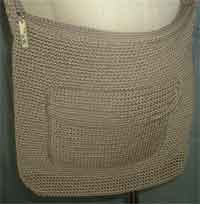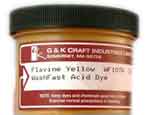Can I dye a nylon purse from taupe to gray?
Name:
Astrid

Message: Hello, I was wondering if this type of nylon product would be able to be dyed with your dye products? From most of the reviews I've read people mostly talk about dyeing clothes so I'm not too sure. Anyway I was thinking of going from this color to a grey color.
If you have this purse already, it will probably dye well. It's not 100% guaranteed, though, so I would not advise you to buy a new purse specifically in order to dye it. Sometimes a commercial item will not take the dye evenly. If you own the purse already and do not like it in its current color, than it's a good idea to try dyeing it.
Nylon can be dyed by heating the purse in a bath of water, dye, and an acid, such as vinegar. You should dissolve the dye in the water, add the vinegar, then add the nylon item that you want to dye, then gradually heat the dye bath up to a maximum of 185°F, no higher. (Higher temperatures might damage the nylon.) You should use an immersible thermometer to watch the temperature of your dyebath.
Once you have reached the desired temperature, reduce the heat under the pot and hold the temperature for half an hour, stirring constantly or at least frequently to help avoid uneven dye uptake, then allow the dyebath to cool to room temperature, and thoroughly wash out any excess dye in lukewarm water. Your choice of a dyeing pot is important. Never heat any acid or base in a pot made of a reactive material such as aluminum or non-stainless steel. The pot must be made either of stainless steel or of unchipped enamel, which will not react with the dye or the acid you need to use with the dye. Also note that you should not reuse a dyeing pot for cooking food, as textile dyes will contaminate the pot.
If you are not sure of the fiber content of the item you are dyeing, then you might have difficulties. While nylon may be dyed with any sort of acid dye (I particularly recommend the WashFast Acid Dyes for nylon), and may also be dyed with the special disperse dye required for polyester, polyester is much pickier, and so is acrylic. Polyester can be dyed only with Disperse dyes, not with acid dyes or all-purpose dyes. Acrylic can be dyed with disperse dyes or with basic dyes, but not with any acid dye or all-purpose dye. Nylon is easier to dye than other synthetic fibers, because it accepts a wider range of dyes.
Before dyeing your purse or anything else, prescour it by washing it well in the hottest water it can tolerate, along with detergent and some extra soda ash (or washing soda) for added cleaning power. Invisible stains can cause uneven dyeing.
(Please help support this web site. Thank you.)

Message: Hello, I was wondering if this type of nylon product would be able to be dyed with your dye products? From most of the reviews I've read people mostly talk about dyeing clothes so I'm not too sure. Anyway I was thinking of going from this color to a grey color.
If you have this purse already, it will probably dye well. It's not 100% guaranteed, though, so I would not advise you to buy a new purse specifically in order to dye it. Sometimes a commercial item will not take the dye evenly. If you own the purse already and do not like it in its current color, than it's a good idea to try dyeing it.
Nylon can be dyed by heating the purse in a bath of water, dye, and an acid, such as vinegar. You should dissolve the dye in the water, add the vinegar, then add the nylon item that you want to dye, then gradually heat the dye bath up to a maximum of 185°F, no higher. (Higher temperatures might damage the nylon.) You should use an immersible thermometer to watch the temperature of your dyebath.
—ADVERTISEMENT—
Washfast Acid dyes
at Paradise Fibers

Washfast Acid dyes
Also known as Nylomine dyes, excellent for use on nylon. One ounce of dye will dye six pounds of fiber!
at Paradise Fibers

Washfast Acid dyes
Also known as Nylomine dyes, excellent for use on nylon. One ounce of dye will dye six pounds of fiber!
Once you have reached the desired temperature, reduce the heat under the pot and hold the temperature for half an hour, stirring constantly or at least frequently to help avoid uneven dye uptake, then allow the dyebath to cool to room temperature, and thoroughly wash out any excess dye in lukewarm water. Your choice of a dyeing pot is important. Never heat any acid or base in a pot made of a reactive material such as aluminum or non-stainless steel. The pot must be made either of stainless steel or of unchipped enamel, which will not react with the dye or the acid you need to use with the dye. Also note that you should not reuse a dyeing pot for cooking food, as textile dyes will contaminate the pot.
If you are not sure of the fiber content of the item you are dyeing, then you might have difficulties. While nylon may be dyed with any sort of acid dye (I particularly recommend the WashFast Acid Dyes for nylon), and may also be dyed with the special disperse dye required for polyester, polyester is much pickier, and so is acrylic. Polyester can be dyed only with Disperse dyes, not with acid dyes or all-purpose dyes. Acrylic can be dyed with disperse dyes or with basic dyes, but not with any acid dye or all-purpose dye. Nylon is easier to dye than other synthetic fibers, because it accepts a wider range of dyes.
Before dyeing your purse or anything else, prescour it by washing it well in the hottest water it can tolerate, along with detergent and some extra soda ash (or washing soda) for added cleaning power. Invisible stains can cause uneven dyeing.
(Please help support this web site. Thank you.)
Posted: Wednesday - December 24, 2008 at 07:52 PM
Follow this blog on twitter here.
Quick Links
- All About Dyes & Dyeing Top -
- Top of this blog -
- FAQ -
- The Dye Forum -
- How to Tie Dye - How to Batik -
- Books - Toys - Plants -
- Top of this blog -
- FAQ -
- The Dye Forum -
- How to Tie Dye - How to Batik -
- Books - Toys - Plants -
More in this category:
- -
Statistics
Total entries in this blog:
Total entries in this category:
Published On: Aug 29, 2012 02:48 PM
Total entries in this category:
Published On: Aug 29, 2012 02:48 PM